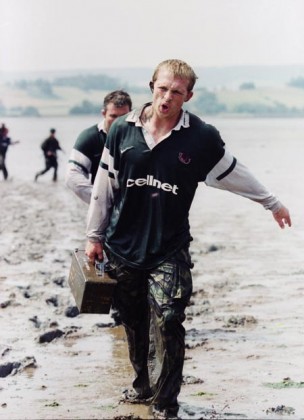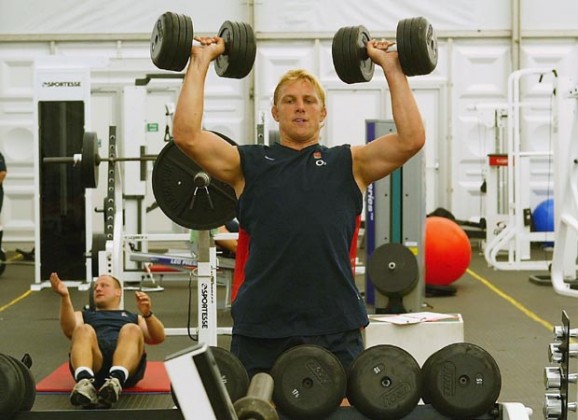 It is difficult to be precise about these things but the first whiff of a training camp – or something out of the ordinary – for the old amateur England came in the early autumn months of 1969 when, sick to death of being regularly steam-rollered by Southern Hemisphere opposition they organised a series of Sunday training sessions at Leicester and Coventry.
It is difficult to be precise about these things but the first whiff of a training camp – or something out of the ordinary – for the old amateur England came in the early autumn months of 1969 when, sick to death of being regularly steam-rollered by Southern Hemisphere opposition they organised a series of Sunday training sessions at Leicester and Coventry.
The get-togethers were at the instigation of the players and, before the first one, newly-appointed coach Don White addressed the assembled troops. The England captain Bob Hiller explains what happened next: “Of course that first session is where the famous Don White story comes from. He gave us a bit of a pep talk about how things were going to change from this point onwards and England were going to be a lean, mean machine etc and finished off by saying, ‘right lads, let’s get this session underway, take up your usual positions’.
“At which point we all went and stood under the posts waiting for a conversion!”
England recorded their first victory over South Africa that day but the experiment died a death only to be revived under Mike Davis in 1980 when, again at the instigation of the players, extra mini-camps were arranged, this time on Monday nights at Stourbridge RFC which is reckoned geographically to be as close to the centre of England as makes no difference.
“We worked really hard, with tremendous purpose for an hour and a half or more, the guys couldn’t get enough, and those sessions became occasions in their own right,” recalls Davis. “I remember nearly missing one because I got caught in a traffic jam of local fans who we encouraged to come along and watch.
“Afterwards the Stourbridge club laid on a tremendous hot meal for the guys – they were real feasts – which were much appreciated. Our time at Stourbridge was one of my happiest rugby experiences.”
The observant among you will also notice that this initiative also resulted in success, indeed a Grand Slam season.
England’s visits to Club la Santa in Lanzarote, circa 1990-3, also coincided with a particularly successful period. Normally held straight after Christmas and taking in the New Year, these were entertaining hybrid affairs mixing an elite approach to training and old-fashioned bonding work in the bar.

England were right on the cusp during this era. You could smell professionalism in the air and many wanted to embrace its work ethic and pursuit of excellence – not to mention financial reward – but as working guys taking time off work there was still a desire to give more than a nod in the direction of old touring habits.
And, of course, the Press were invited on these adventures and given unlimited access, which would never happen these days. One time we arrived in the land of winter sun to be greeted by a phalanx of world-class athletes headed by Merlene Ottey and Steve Backley in the Club la Santa foyer and their presence seemed both an inspiration and diversion.
The thing about real athletes on winter training camps is that they tend to get up at the crack of dawn, do a couple of hours of very high quality work and then spend the rest of the day “recovering” at the poolside cafe, occasionally wandering off for a relaxing massage or stretch.
Unless you are up with the lark you might conclude that nothing much happens. England, starting at a more sedate hour, witnessed only the lounge-lizard part of that poolside regime and laboured for a while under the false impression this could miraculously foster world-class fitness levels. The reality was much different.
In truth, England worked hard enough – gym work, messing around with strange new things called swiss balls, shuttle runs, sprint testing and loads of set-piece practice – and there were some genuinely revelatory moments. Over the course of three camps you could, for example, see Brian Moore morph into a world-class hooker courtesy of his much improved fitness and willingness to embrace the new training regime.
While others cut corners and hurled good-natured abuse in his general direction Mooro worked like a dog as he disappeared over the horizon. England’s superb 1992 Six Nations campaign came off the back of a particularly good training camp at Lanzarote.
At least one of the many lineout sessions seemed pretty crucial, both then and in retrospect, to the future of English rugby. One morning the gathered Press assembled on the touchline – a pitch was marked out inside the athletics track – and watched open-mouthed as a youthful, uncapped and basically unknown Martin Johnson took Wade Dooley to the cleaners.
My memory is that the session ended in an almost embarrassed, shocked, silence. A long reign was clearly coming to an end. Six weeks later Johnson made his international debut against France, the start of his stellar career.
The biggest bonus of those Lanzarote trips, apart from the sun on your back in early January, was still the relaxed kickbacks and coffees in the late afternoon sun after training was done or the occasional impromptu sessions in the bar.

Will Carling recalls: “One New Year’s Eve, Mark Linnett appeared in the bar wearing Merlene Ottey’s running leotard which he had ‘borrowed’ from her washing line from the apartment next door.
“He returned it early the following morning about nine sizes bigger. I’m not quite sure what Merlene made of that. Nothing was mentioned the following day.”
Before the 1999 World Cup Sir Clive Woodward took his England squad down to the Commando training centre at Lympstone on the banks of the River Exe to toughen them up and invited the course trainers to compile profiles of all the players on view and their suitability for leadership roles.
Four scorching days ensued with mock rescues in burning barracks and the usual obstacles courses and teamwork exercises while one night they were dumped in the middle of nowhere and told to make their way back as best they could.
All of which reminds me of a “camp” I attended with London Irish around this time with Dick Best placing his troops in the hands of the Army at Sandhurst where a battle-hardened Gurkha platoon were in residence after a recent spell of active service. The morning I arrived, in time for a bacon buttie and hot brew, the Irish boys were looking particular bleary-eyed and exhausted as they stumbled around their canvas village cursing audibly. Best meanwhile was chuckling quietly to himself.
Why so? Later that day the chance arose for a quiet word. What was going on this morning I asked? “Ah well, you see it was a sort of sleep deprivation exercise I suppose. When the boys turned in I told them that the Gurkhas were going to be on night patrol with their kukri knives and they were going to ‘liberate’ something from each of their tents by dawn without any of them noticing. There was a look of apprehension on the lads’ faces I can tell you.
“Of course the Gurkhas were doing nothing of the sort. They dined in the mess and then spent all night in the comfort of their beds in the main barracks. But our boys were on red alert all night, every rabbit or fox moving in the undergrowth had to be a Gurkha closing in, every screech from a bird in the trees a sign of the silent enemy. By dawn they’d had enough and were up fixing breakfast and huddled around the fire. Gary Halpin insisted he had seen, and frightened off, two of the Gurkhas.”
Talking of noises in the night, Brian O’Driscoll’s main memories of the cryotherapy chambers in remote Spala were falling asleep to the howls of wolves in the nearby woods. Ireland, under Warren Gatland, started going to Poland long before he took Wales there and the visits continued on and off even when he left them for Wasps.
O’Driscoll found short sharp visits of 4-5 days particularly useful when trying to overcome the various hamstring tears and strains he somehow kept at bay for most of his career. Early in the 2005 Six Nations he was struck down with what seemed like a bad tear and headed straight for Spala in the hope of accelerating his recovery and missing just the one game.
He says: “It was midwinter, the days were short and snow heavy. My routine was three pool and rehab sessions a day with a quick burst in the cryotherapy chamber after each session and the last one was in the evening when it was pitch dark. My accommodation was quite a walk from the centre so every day ended with a walk in the snow back to my hut with the wolves beginning to sound off. I was always glad to get to the front door.”
There is a lot of psychology in getting the mood of these camps just right. Some are just sweatshops, nothing more or less, designed to lay down a base level of fitness while others, while also including a deal of physical work, look to tick a few other boxes.
When Brian Lochore took over as the New Zealand coach for the 1987 World Cup he faced a very odd situation when the squad arrived in camp. Being Kiwis they were all fit as fiddles but their body language was very hangdog. Some were still getting abused for going on the 1986 ‘Cavaliers’ tour of South Africa when the New Zealand public, wrongly or rightly, suspected they had been handsomely rewarded for supporting the apartheid regime.
“At the beginning it had been so rough on a lot of those players they wouldn’t go downtown with anything that identified them as All Blacks in case they got abused,” recalls Lochore. “So I decided there needed to be a closer connection still with New Zealand’s rugby heartland and arranged for them to spend a day ‘going bush’ in rural Wairarapa where all the players would also be billeted out for the night.

“I wanted them to go for two nights but they were a little uneasy, so I made it just the one. They rode horses, motorbikes, went shooting or fishing and then, when we got on the bus to go back to Wellington, just about in unison they said, ‘why couldn’t we stay two nights?’ My answer wasn’t repeatable.”
Without doubt the most notorious of all rugby camps was South Africa’s Kamp Staaldraad, a military style boot camp run by the South African police, near Thabazimbi, where coach Rudi Straeuli took his chronically under-performing squad before the 2003 World Cup. The literal Afrikaans translation of Kamp Staaldraad is “camp of barbed wire”, by the way.
Details of the camp started to emerge soon after South Africa had bombed during that World Cup when they came up badly short against England in their pool match and then against New Zealand in the quarter-finals.
The reports alleged that among other things that players were ordered to jump naked into a freezing lake and pump up rugby balls under water. And if they tried to get out of the lake they were ordered back at gunpoint.
The Kamp authorities acknowledged that firearms were present but insist that they were not used. The South Africa squad were also reportedly ordered to climb into a foxhole naked and sing the national anthem while ice cold water was poured over their heads while players were forced to crawl naked over gravel.
South Africa seemed under the erroneous impression that they were going to war rather than participating in a rugby contest.
It all sounds horribly gruesome although the cynic in me wonders if there would have been quite such and outcry if the Springboks had stormed to a surprise World Cup victory in which case it might have been hailed as a brutal but masterful toughening up process.
Anyway the fall-out all proved too much for Straeuli who resigned although his miserable 52 per cent win record while in charge of the Boks would probably have seen him dismissed in any case.























